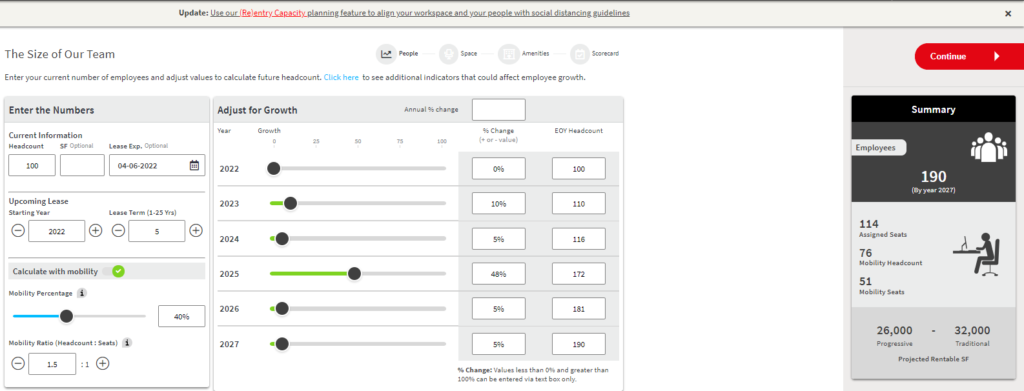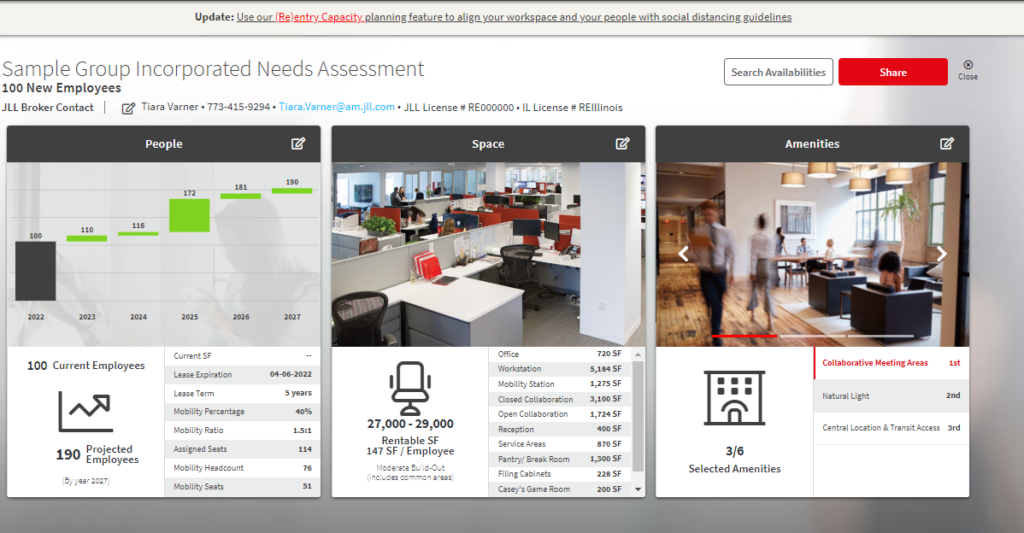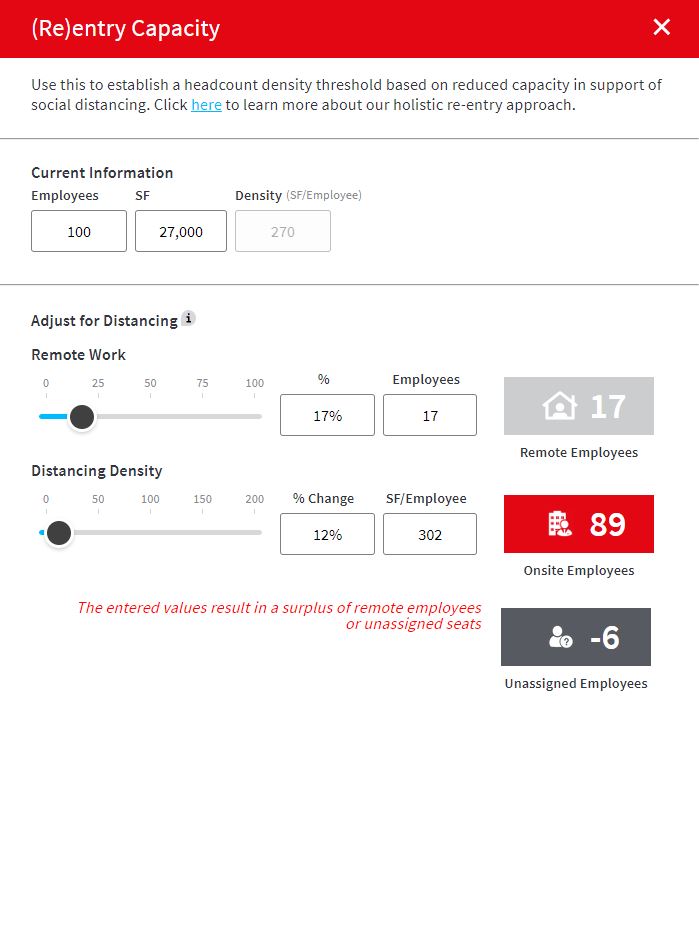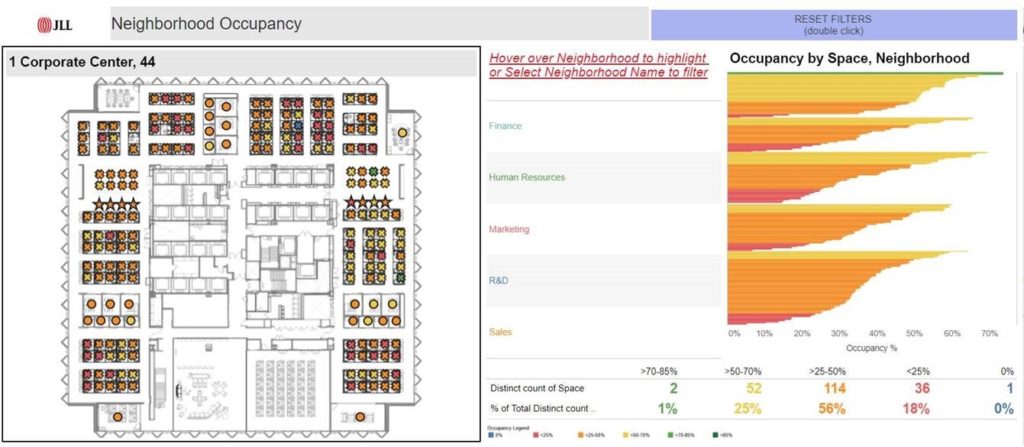Relying on high-tech means to overcome office challenges in the COVID era
“People will never go back to the offices again.”
“It’s too unsafe. It’s a health risk.”
“Remote work is working too well.”
That was the national sentiment in early 2020 as the wave of COVID-19 crashed over the United States. Suddenly, companies started questioning whether they’d ever use their office space the same way again.
The JLL team here in Indy believes in decisions based on data. That’s why we conducted a seven-week survey to understand the shifts in remote working, preparedness and productivity.
The findings?
- The longer people work from home, the more comfortable they become. Before COVID, only 13 percent of employees surveyed worked remotely three or more days per week. However, 28 percent of employees agreed that they’d like to work from home three or more days per week even after it’s safe to return to the office.
- As people have built a habit of working from home, they are self-reporting higher productivity numbers each week. The number of employees who are reporting that they are more productive at home than in the office doubled from the first week to the most recent week.
- While employees seem to be adapting to and enjoying their work-from-home lifestyle, they are missing the interpersonal experience of the office. Week over week, the top three things people miss about the office are collaborating, socializing and supporting the work of others.
It’s clear that the office still has a critical function to job satisfaction and company culture, but many leaders have questions about the role remote work will play in their larger workplace strategy:
- If our employees are just as productive working from home, should we shift all or a portion of the workforce to a remote work strategy?
- How would our footprint and capital expense be impacted if we integrate remote work flexibility into our strategy?
- How can we understand how many people were actually in our office pre-COVID on a day-to-day basis?
- What are people missing about gathering in office spaces?
- In the world of spatial distancing, how many people can we fit in our office at one time?
JLL’s primary weapon to help companies navigate these unknowns is something we’ve been focused on intently for the last five years: technology. JLL has continually invested in property technology or “PropTech” initiatives through JLL Spark, a strategic global venture fund investing in startups transforming commercial real estate. We’ve leveraged technology internally to bring greater transparency, efficiency and results to our clients.
Seemingly overnight, COVID shone a spotlight on our efforts to lead with tech. Here are the technologies we’re leveraging most heavily right now to help Indianapolis companies navigate office re-entry.
3 High-Tech Solutions for COVID-Era Commercial Real Estate
1. Assessing dynamic real estate needs
JLL’s Needs Assessment tool helps organizations quickly and easily define the space criteria and priorities to match with the market. It can help an organization’s leaders define space needs based on headcount, workstyle and most needed amenities.
>> Real Company Example: In one instance, prior to meeting with JLL, a rapidly growing tech company was looking for 18,000 square feet of office space. After quickly running through the assessment to consider remote work, mobility and changing space needs, they realized they only needed 12,000 square feet—a 30-second exercise that resulted in $1.2 million savings over the term of their lease.


(Re) Entry Capacity Planning Calculator
As part of the assessment, our proprietary (Re) Entry Capacity Planning Calculator is a quick, repeatable solution used to understand spatial distancing and remote work impact on the office footprint. A user simply inputs desired density and number of remote employees, and the calculator immediately generates the crucial information needed to plan safe re-entry—including how many employees can be in the office while maintaining a safe social distance.

>> Real Company Example: Recently, when a large banking corporation was faced with planning its workforce re-entry strategy, it was unclear how social distancing would impact its existing space. Using JLL’s calculator, the team evaluated different social distancing and remote work scenarios in minutes. They found that, due to the size of the remote workforce, they actually had more than enough space to bring their entire in-office workforce back in one phase.
2. Identifying a space
Evaluating market availability
Using the information generated by the assessment, JLL’s market tool enables an organization to match with available buildings and space in any metro market within minutes. It provides detailed building information related to growth and available space, and creates customizable reports for distribution to align all key stakeholders around a path forward.
Visualizing the market
JLL’s U.S. patent-protected visualization platform enables us to show clients properties across the country and share a complete view of the location without ever arriving onsite. It is a huge benefit to clients when shelter-in-place guidelines were imperative to keeping everyone safe.
To visualize the market, technology creates a 3D rendering of a property, complete with stackable floor plans. Even more exciting, it also lets users layer-in important, localized factors such as future tax incentives, proximity to public transit, average rental rates, nearby cafes and planned construction nearby.
>> Real Company Example: We received a call from a client to prepare a stakeholder presentation of available property options—with 24-hour notice. Instead of spending countless resources to coordinate and schedule in-person tours, we were able to leverage the market visualization tool to prepare a 5-minute video fly-through of all development options that stakeholders could view from anywhere (and deliver it to the client ahead of schedule).
3. Optimizing occupancy data
The average organization only utilizes 60 percent of building space to its fullest potential, making the other 40 percent an opportunity to right-size or redesign for better employee productivity and happiness.
Instead of guessing the utilization rate for each individual company, we can aggregate real-time utilization data to generate insights for optimizing occupancy potential, elevating employee experience and eliminating the costs of underutilization.
The proprietary platform leverages data from any sensor product, security badging system, room reservation system or WiFi network technology to help analyze occupancy and utilization patterns.
These analytics drive better decision-making to optimize space and employee experience.
>> Real Company Example:

Can tech help you redefine your workplace strategy?
Living and working through a global pandemic has forced us all to become a little more comfortable with the unknown. Luckily, your workplace strategy doesn’t have to remain a mystery.
If you’re trying to determine your ideal in-office versus remote work ratio, whether you should sublease your space or grow your footprint, if low-capital-cost alternatives exist for your situation, or how to handle re-entry over the next 12-18 months, our team can help. However your company works best—virtual consultations, recorded sessions or in-person, socially distanced meetings—we’ll meet you there.
Questions? Reach out to JLL Managing Director Matt Waggoner directly at matt.waggoner@am.jll.com to learn more.




